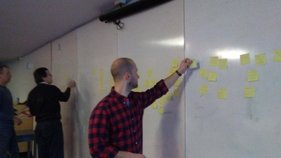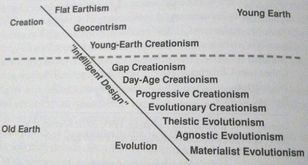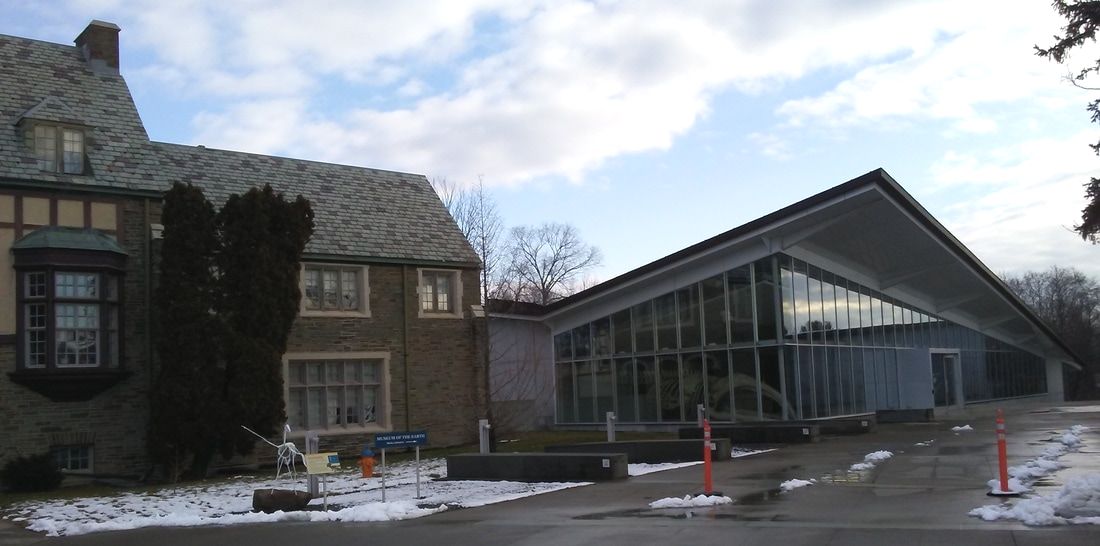|
Evolution vs. Creationism. It's a book. And, engendering this interesting read, evolution vs. creationism is still a hot topic and source for controversy in communities across America. Accepting evolution isn't a question for most scientists (~98% accept it), but it is an ongoing debate in the public realm, especially in the context of teaching it in schools. This post was inspired by "Evolution vs. Creationism: An Introduction" (Scott, 2009). I'd recommend this book to anyone looking to learn about the evolution controversy in America and gain insight on the historical development of the creationist and intelligent design movements. The book: part 1= science, religion, evolution, and creationism; part 2= a history of the creationism/evolution controversy; part 3= excerpts from the literature -- nicely organized with a topic summary and a point-counterpoint format.
What is the distinction in the different types of evolutionism? Theistic, agnostic, and materialist evolutionists. Members of all categories accept evolution as operating under natural laws of nature. Theistic evolutionists -- for instance, Catholics and mainstream Protestants -- are those who hold belief in a higher being who is involved at some level in the course of evolution. Agnostics are uncertain about the reality of God, but aren't too dogmatic about their beliefs. Materialist evolutionists include humanists and atheists, who believe supernatural forces do not exist. Scientists can accept evolution yet still hold religious beliefs. Scientists can be methodologically naturalistic evolutionists who are concurrently theists. Put simply, this means they carry out their research under the assumption that answers can only come from the material, natural world. This applies to both origin science (singular events) and operation science (recurring events tested by experimentation). The supernatural cannot be invoked, because if non-testable, supernatural forces are allowed, then the work would no longer be in the realm of science. teaching evolution in grades K-12
The book shines in its detail of judicial rulings that have led up to our states' current laws on teaching evolution in the classroom. Here's how it brings a recent South Dakota bill (SB 55) into context. Senate Bill 55 (link to South Dakota legislature site)
Purpose: protect the teaching of certain scientific information. Content: "No teacher may be prohibited from helping students understand, analyze, critique, or review in an objective scientific manner the strengths and weaknesses of scientific information presented in courses being taught which are aligned with the content standards established pursuant to § 13-3-48" [state code governing state education standards revision cycle & contents]. Status: bill has passed the Senate and has gone to the House. Currently deferred until Feb. 13, 2017. Status update [Feb 17]: after being deferred again, it's been scheduled for hearing on Feb. 22. Status update [Feb 22]: the bill was not passed. The vote was 6 yeas and 9 nays. Status update [Feb 22]: the bill has been defeated. On Feb 22, a motion was passed (11-4-0) to defer SB 55 to the 41st Legislative Day. Because there are only 40 legislative days this year, this effectively kills the bill. Some opponents of the bill were listed on the South Dakota legislative website. Among others, they included representatives from the SD school board, the Sierra Club, and the Presentation Sisters (nuns with a mission in education). So why is there concern over this bill? The wording makes it sound like a good thing. And maybe the intention is noble. But, from previous rulings on intelligent design and the evolution curriculum, there is precedence demonstrating how a judge may determine that the bill is actually meant to weaken science instruction, not strengthen it. Historical background: In America, we have a tradition of free speech. We also have a decentralized educational system, and a decentralized religious history which has contributed to a theological divide in regional churches. State legislatures repeatedly introduce laws requiring evolution is taught with caveats, such as putting 'warning' stickers on textbooks or giving equal time to intelligent design. A few court cases: The famous 1935 Scopes Monkey Trial in Dayton, Tennessee pitted the fundamentalist William Jennings Bryan against Clarence Darrow, who was defending John T. Scopes for teaching evolution in the public schools. Scopes lost. Antievolution laws remained. The amount of evolution in textbooks decreased for the next two decades and conflicts ensued when evolution was revived in the 1950's. A landmark ruling was the Supreme Court case Lemon v. Kurtzman 1971, which all creationism cases since have cited. It applies a three-part test to determine if the law violates the Establishment Clause of the First Amendment. To wit, a bill must have a secular purpose, must not either promote or inhibit religion, and must not create undue entanglement between government and religion. The 1980's saw the onslaught of equal time legislation in 27 states; bills that required equal time to be given to evolution and creationism. Only two states passed them into law -- Arkansas and Louisiana -- and both were eventually overturned (McLean v. Arkansas and Edwards v. Aguillard). McLean declared that creation science failed as a science, and Edwards ruled on the Establishment Clause. However, Edwards suggested loopholes, recognizing that teachers could "supplant the present science curriculum with the presentation of theories, besides evolution, about the origin of life." More recently, a case in Pennsylvania: Kitzmiller v. Dover 2005. A policy was introduced by the school board that would require that teachers read a disclaimer about "Darwin's Theory of Evolution" and state that it is not a fact, and students must be instructed to "keep an open mind". Teachers must also have the intelligent design textbook, "Of Pandas and People" available for students to reference. In the end, Judge Jones gave a complete victory to the plaintiffs and declared Dover's educational policies to be unconstitutional. However, Kitzmiller is not precedential outside of its district. Returning to the bill at hand, we can use these cases to adduce how the South Dakota Senate Bill 55 could be construed as antievolution (or, antiscience). Again, the bill: "No teacher may be prohibited from helping students understand, analyze, critique, or review in an objective scientific manner the strengths and weaknesses of scientific information presented in courses being taught ..."
The book "Evolution vs. Creationism" illuminated these arguments. I hope I've shed some light on why there is concern over SB 55, and how the important goal of instilling critical thinking skills in children may in actuality be language used with the intention to promote intelligent design and encourage an antievolution message. 
Creationist Graffiti? A recent trip to a state park in Ithaca showed someone had decided to revise geologic history. The "past two million years" was replaced with "past many years" and the age when the glaciers melted was altered from 12,000 to 4,000 years ago, presumably because the earth could not be over 12,000 years old.
reference: Scott, E. C. (2009). Evolution vs. creationism: An introduction (Vol. 62). Univ of California Press.
1 Comment
For our Danforth lab NSF grant (see summary), we are developing a museum exhibit on the diversity of bees, which will be traveling around the country for several years. The first site will be at the Museum of the Earth, in Ithaca, New York. It's been great working with the Paleontological Research Institution (PRI) on this project!
 The process of defining our overarching concept: We are working with Rob Ross and Beth Stricker (from PRI), and Beth's been leading us through some neat exercises in brainstorming. In the initial session, we individually reflected on essential information and key concepts, and wrote short phrases on Post-it notes. In the photo at right we are putting them on the board, clustering by subject to see where the major areas of overlap appear. Our goal was to determine one 'big idea' -- summarized in a single sentence -- that would guide our entire 600 square foot exhibit. From that framework, we also solidified three main themes and laid out quantifiable objectives for what we want visitors to retain after exiting. Traveling museum exhibits are shipped from place to place, so they need to be constructed from the ground up and be sturdy for set-up and take-down. Traveling exhibits will typically be displayed at three to four locations a year, and are built with the intention that they will last three to eight years. With the size of our exhibit, it can be housed in large institutions, but will also be popular with smaller venues, such as regional museums and libraries, potentially coupled with public education activities. Update from Feb. 2019: The content and displays are in development, and the exhibit will be opening September 2019!
|
PhyloBlogCovering topics of phylogenetics and systematics & other science-related news. Archives
October 2019
Categories
All
|



 RSS Feed
RSS Feed